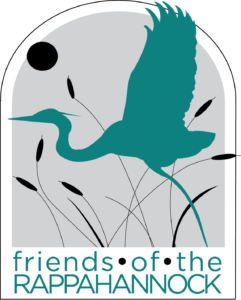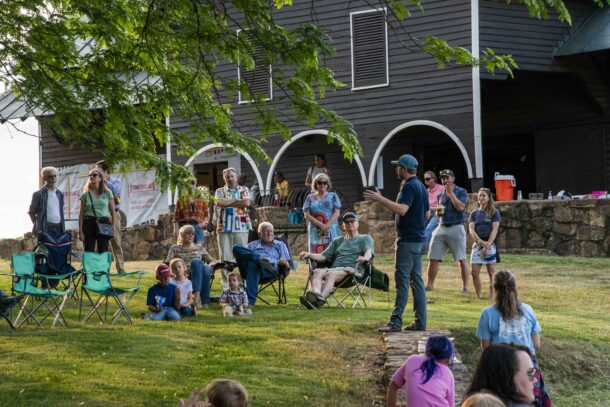Why wetlands are important, the history of their degradation and how we are working to restore them in the Rappahannock River watershed and beyond.
Historical unrecognition of the many cultural, economic and personal benefits of wetlands to humans has led to widespread wetland destruction. The Nature Conservancy is partnering with Friends of the Rappahannock to accelerate non-tidal, voluntary wetland restoration in the Rappahannock River watershed.
What is a wetland?
A ‘wetland’ – it is an area of land that is flooded by water at some point during the year, either permanently or seasonally. Wetlands can be tidal, located in coastal areas that are regularly inundated by tides, or non-tidal, located inland in areas with no tidal influence. Most wetlands within the United States are non-tidal.
Why are wetlands important?
Wetlands offer many benefits to humans. In fact, they are probably benefiting you in some way every day!
Do you live on or near a river or stream? These natural filters may be protecting your property from erosion and flood damage! Wetlands are critical to combating erosion, thus reducing sediment loads and other forms of pollution from reaching waterways. Wetlands help to significantly reduce flooding by temporarily storing stormwater and slowly releasing it, therefore reducing the intensity of downstream flooding and erosion.
Do you enjoy being out in nature? Wetlands provide aesthetically pleasing views and host abundant wildlife for you to appreciate! They provide resting, feeding and breeding areas for many waterfowl and other migratory bird species. Fish and crab populations also depend on coastal wetlands for food, habitat and breeding during some part of their lifecycle. Wetlands are also among some of the most productive ecosystems in the world, up there with coral reefs and tropical rainforests! Wetland plants provide long-term storage of carbon dioxide in below-ground-biomass by means of photosynthesis and sediment deposition. This is called carbon sequestration, a process that helps to reduce greenhouse gas emissions and combat climate change.
Do you like to bird, hunt or fish? Wetlands provide a space for these and other types of recreational activities. They allow for tourism, education and research too! Wetlands benefit surrounding communities both economically and culturally. Hunting, birding and fishing within these ecosystems act as significant sources of recreational revenue. Due to their unique combination of physical and chemical processes and terrestrial and aquatic life, wetlands also provide special educational and research opportunities.
If wetlands are so beneficial, why haven’t they always been protected?
While we are aware of the benefits provided by wetlands now, this has not always been the case historically. Historical wetland loss can be accredited to colonization, technological innovations and drainage for agricultural land use. By the 1920s, 70% of original wetland acreage within the contiguous United States had been modified.
There has been increasing awareness about the environmental functions of wetlands since the environmental movement of the 1960s and 70s. It was then that federal policy changes, such as the reorganization and expansion of the Clean Water Act, were created to curtail wetland loss. These changes helped make some headway, but not enough. For instance, in the 1950s and 60s, about 600,000 acres of wetlands were lost per year. By the 1970s and 80s, although federal policy changes cut the acreage lost per year in half (about 300,000 acres), there was still a lot of work to do. The need to make significant strides prompted restoration work throughout the United States, including in the Chesapeake Bay region.
What is wetland restoration?
In order to return a former or degraded wetland to its natural functions, physical, biological and chemical characteristics of the ecosystem are manipulated. Restoration practices can include both re-establishment, where a former wetland is rebuilt, or rehabilitation, where the functions of a degraded wetland are repaired. Wetland restoration strategies include, but are not limited to, invasive species control, tree planting and the manipulation of water flow.
What’s happening in the Chesapeake Bay?
In 2014, the Chesapeake Bay Watershed Agreement was created with a vision of an environmentally and economically sustainable watershed with clean water, conserved lands and a diversity of engaged citizens and stakeholders. Under this agreement, a Wetlands Goal to create or reestablish 85,000 acres of wetlands by 2025 was generated.
Considering there are 1 million acres of potentially restorable wetlands in the Chesapeake Bay watershed, this goal should be relatively attainable. However, as of 2017, only 11% of the 85,000 acres of wetlands had been restored. In an effort to make significant progress towards meeting this goal, many organizations, including The Nature Conservancy (TNC), are working to accelerate wetland restoration in the Bay watershed. TNC is focusing its energy on voluntary, that is not required by regulations, non-tidal wetland restoration in 3 key areas of the Bay watershed: 1) the Delmarva peninsula, 2) south-central Pennsylvania and 3) the Rappahannock River watershed.
So, why is the Rappahannock River watershed considered a key area for wetland restoration?
Not only does this area contain the lowest percentage of shoreline with intact vegetated riparian buffers, but it also has the second highest percentage of agricultural land area. This makes the Rappahannock River watershed a priority area for reducing sediment loads to the Bay. This area also provides a great opportunity to protect and restore wetlands for Black Duck habitat, a migratory species that spends its winters in the Chesapeake Bay. Historically, over 200,000 black ducks wintered in the Chesapeake Bay. Today, this number has dwindled to about 52,000.
In the Rappahannock River watershed alone, there are over 200,000 acres of wetland restoration opportunities. Yet, the state of Virginia has only met 2% of its restoration goal. TNC is working to enhance partner capacity to accelerate voluntary non-tidal wetland restoration in the Rappahannock River watershed through building relationships with local landowners. One of the partners involved in this work is the Friends of the Rappahannock (FOR). FOR is working with TNC to provide outreach to landowners about restoration programs in the Northern Neck and Middle Peninsula regions of the lower Rappahannock watershed.
How can you help implement wetland restoration?
One of the major programs available to landowners in the lower Rappahannock River watershed is the Wetland Reserve Easement (WRE) program. Through the National Resources Conservation Service (NRCS), this program provides technical and financial assistance to landowners through a conservation easement. Eligible WRE participants include landowners and native American tribes who own farmed or prior converted wetlands that can be successfully and cost-effectively restored.
If you are a landowner in the lower Rappahannock River watershed and are interested in enrolling in this type of program to directly help protect, restore and enhance wetland habitats and the benefits they provide, please reach out to Lower River Steward Libby Bieri. Thank you for helping wetlands help us all!
This blog post was written by Lower River Steward Libby Bieri and published November 2022. This post was created in cooperation of the Nature Conservancy and Friends of the Rappahannock.






